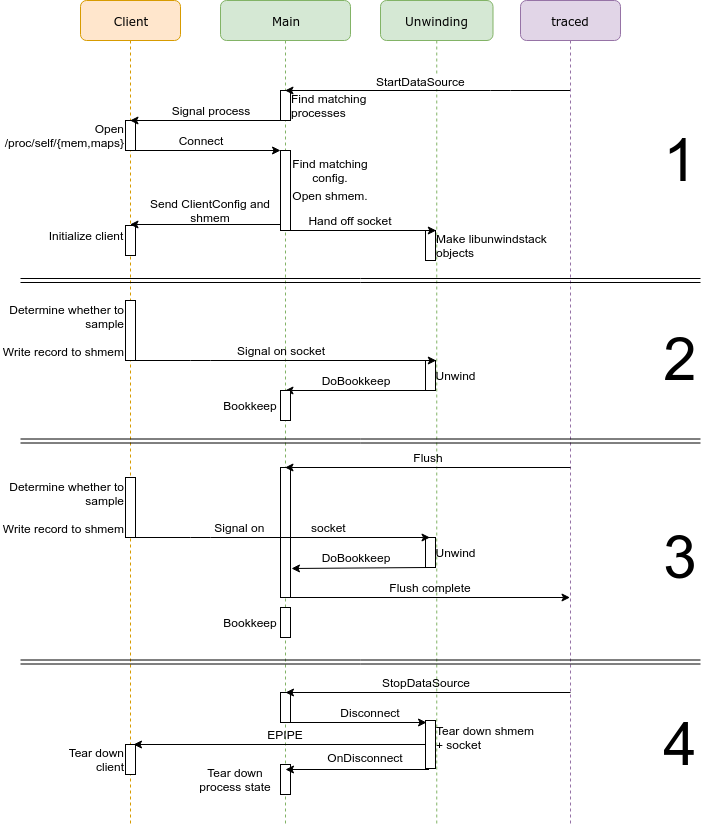heapprofd: Shared Memory
Status: Implemented
Authors: fmayer
Reviewers: rsavitski, primiano
Last Updated: 2019-02-11
Objective
Restructure heapprofd to make use of the SharedRingBuffer.
Overview
Instead of using a socket pool for sending callstacks and frees to heapprofd, we use a single shared memory buffer and signaling socket. The client writes the record describing mallocs or frees into the shared memory buffer, and then sends a single byte on the signalling socket to wake up the service.

High-level design
Using a shared memory buffer between the client and heapprofd removes the need to drain the socket as fast as possible in the service, which we needed previously to make sure we do not block the client's malloc calls. This allows us to simplify the threading design of heapprofd.
The Main Thread has the Perfetto producer connection to traced, and handles incoming client connections for /dev/socket/heapprofd. It executes the logic for finding processes matching an incoming TraceConfig, matching processes to client configurations, and does the handshake with the clients. During this handshake the shared memory buffer is created by the service. After the handshake is done, the socket for a client is handed off to a particular Unwinder Thread.
After the handshake is completed, the sockets are handled by the assigned Unwinder Thread's eventloop. The unwinder thread owns the metadata required for unwinding (the /proc/pid/{mem,maps} FDs, derived libunwindstack objects and the shared memory buffer). When data is received on the signaling socket, the Unwinding Thread unwinds the callstack provided by the client and posts a task to the Main Thread to apply to bookkeeping. This is repeated until no more records are pending in the buffer.
To shut down a tracing session, the Main Thread posts a task on the corresponding Unwinding Thread to shut down the connection. When the client has disconnected, the Unwinding Thread posts a task on the Main Thread to inform it about the disconnect. The same happens for unexpected disconnects.

Ownership
At every point in time, every object is owned by exactly one thread. No references or pointers are shared between different threads.
Main Thread:
- Signaling sockets before handshake was completed.
- Bookkeeping data.
- Set of connected processes and TraceConfigs (in
ProcessMatcherclass).
Unwinder Thread, for each process:
- Signaling sockets after handshake was completed.
- libunwindstack objects for
/proc/pid/{mem,maps}. - Shared memory buffer.
Detailed design
Refer to the following phases in the sequence diagram below:
1. Handshake
The Main Thread receives a TracingConfig from traced containing a HeapprofdConfig. It adds the processes expected to connect, and their ClientConfiguration to the ProcessMatcher. It then finds matching processes (by PID or cmdline) and sends the heapprofd RT signal to trigger initialization.
The processes receiving this configuration connect to /dev/socket/heapprofd and sends /proc/self/{map,mem} fds. The Main Thread finds the matching configuration in the ProcessMatcher, creates a new shared memory buffer, and sends the two over the signaling socket. The client uses those to finish initializing its internal state. The Main Thread hands off (RemoveFiledescriptorWatch + AddFiledescriptorWatch) the signaling socket to an Unwinding Thread. It also hands off the ScopedFiles for the /proc fds. These are used to create UnwindingMetadata.
2. Sampling
Now that the handshake is done, all communication is between the Client and its corresponding Unwinder Thread.
For every malloc, the client decides whether to sample the allocation, and if it should, write the AllocMetadata + raw stack onto the shared memory buffer, and then sends a byte over the signaling socket to wake up the Unwinder Thread. The Unwinder Thread uses DoUnwind to get an AllocRecord (metadata like size, address, etc + a vector of frames). It then posts a task to the Main Thread to apply this to the bookkeeping.
3. Dump / concurrent sampling
A dump request can be triggered by two cases:
- a continuous dump
- a flush request from traced
Both of these cases are handled the same way. The Main Thread dumps the relevant processes' bookkeeping and flushes the buffers to traced.
In general, Unwinder Threads will receive concurrent records from clients. They will continue unwinding and posting tasks for bookkeeping to be applied. The bookkeeping will be applied after the dump is done, as the bookkeeping data cannot be concurrently modified.
4. Disconnect
traced sends a StopDataSource IPC. The Main Thread posts a task to the Unwinder Thread to ask it to disconnect from the client. It unmaps the shared memory, closes the memfd, and then closes the signaling socket.
The client receives an EPIPE on the next attempt to send data over that socket, and then tears down the client.

Changes to client
The client will no longer need a socket pool, as all operations are done on the same shared memory buffer and the single signaling socket. Instead, the data is written to the shared memory buffer, and then a single byte is sent on the signaling socket in nonblocking mode.
We need to be careful about which operation we use to copy the callstack to the shared memory buffer, as memcpy(3) can crash on the stack frame guards due to source hardening.
Advantages over current design
- Clear ownership semantics between threads.
- No references or pointers are passed between threads.
- More efficient client using fewer locks.
Disadvantages over current design
- Inflates target process PSS / RSS with the shared memory buffer.
- TaskRunners are unbounded queues. This has the potential of enqueueing a lot of bookkeeping work for a pathologically behaving process. As applying the bookkeeping information is a relatively cheap operation, we accept that risk.
